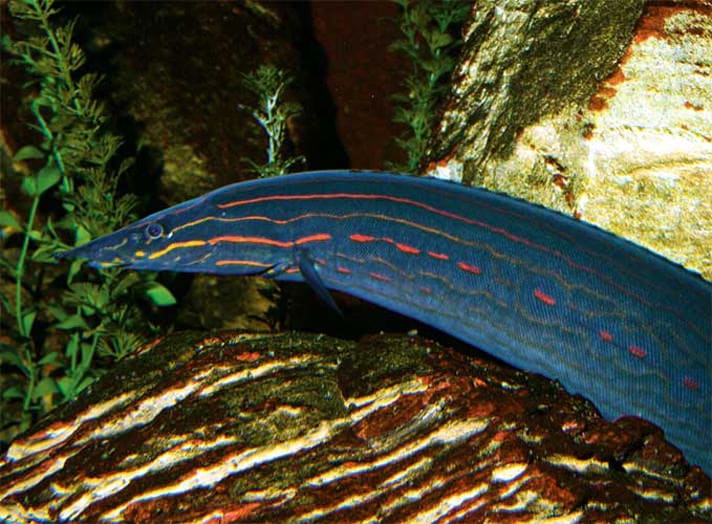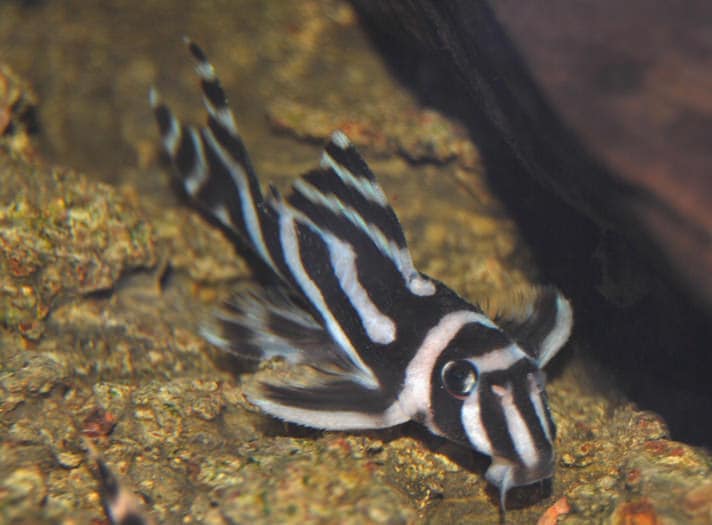Make no mistake—the fire eel is one beautiful freshwater fish. It has distinctive red stripes and markings all over its muddy brown body.
This Southeast Asian native freshwater fish is found in the lowland rivers of Vietnam, Thailand, Myanmar and Sumatra. Despite the name, it’s not a true eel—though it resembles one with its long body and pointed snout.
As adults, fire eels are nearly 3 feet long. And despite its pretty markings, owning a fire eel is not for the faint-hearted or first-time fish owners.
“If you want to keep a fish that swims around the tank and is on constant display, the fire eel is not a good choice,” says John Virata, long-time fish hobbyist and former fish magazine editor. “These fish can be secretive, are moving about when you are sleeping and spend much of their time buried in the sandbed.”
Still want to get one? Here are some facts and tips on keeping a fire eel so it thrives.
1. Fire eels need lots of room.
Most of the fire eels sold at local fish stores or online are young, so they usually are only 8-12 inches long, but fire eels do grow bigger. For that reason, you’ll need to size up your tank about every year to accommodate your freshwater fish.
“You should consider a minimum 75-gallon fish aquarium to successfully keep this species,” Virata says, “with a 120-gallon tank as the best option since these fish can grow very large.”
2. Fire eels like to hide.
Fire eels generally are shy creatures. They also prefer to burrow in the sand, Virata says. Because of that, make sure you use sand for the substrate in your aquarium—not gravel, which can scratch up the flesh of your fire eel. Besides sand to burrow in, give your fire eel other places to hole up, including pieces of driftwood, like SubstrateSource’s Cholla Wood, and PVC pipes.
Fire eels also like a home with lots of plants, Virata says. Just remember that because of his tendency to burrow, your fire eel will likely uproot the plants, which means you must replant the aquarium often.
3. Fire eels are nocturnal.
A fire eel likes to feed and swim around during the night. If you keep the room and tank dimly lit, your pet fire eel might come out more often during the day.
4. Fire eels don’t play well with others.
If your fire eel has tank-mates, make sure they are larger than your fire eel’s mouth, or he might gobble them up. These freshwater fish don’t breed in captivity, so you can only have one at a time.
While an adult fire eel can tolerate a younger one, these freshwater fish have been known to fight among themselves and behave aggressively toward other fish in the spiny eel family.
5. They don’t eat commercial pellets.
You can feed young fire eels a steady diet of bloodworms. To really grow and stay healthy, a fire eel needs a well-rounded diet of shrimp, fish (like chopped bits of tilapia), insects and earthworms. Don’t bother with ordinary fish food; a fire eel won’t be interested.
6. Keep the water temperature steady.
Fire eels are sensitive to high and low temperatures, Virata says.
“Keep them in water temperatures ranging between 75 and 82 degrees Fahrenheit (24° and 28°C),” he says. “This mimics the water temperatures of the Southeast Asian countries where they are found in the wild.”
At the very least, you’ll need a thermometer to gauge the water temperature. And you may need a submersible heater if you live in a cold climate. (Some can be preset to keep the water at its optimal range.)
7. Pay attention to pH balance too.
You’ll want to keep the water at a pH level of 6-7 for your fire eel. Otherwise, too high or too low levels can stress out your freshwater fish and make him more susceptible to illness.
To test the water, use litmus paper (found at pet supply stores). If the pH levels aren’t quite right, use a water-treatment solution to raise or lower its pH.
8. Find other fire eel lovers.
Most experts agree that you must be moderately experienced in the freshwater fish world to own a fire eel. But if you’re a first-timer who already owns one, Pauli recommends finding a mentor. Go online to fish forums or find a local fire eel owner so you have all the information you need to help your new finned friend thrive.
By: Linda Rodgers
Featured Image: Via Oliver Lucanus
Share:










